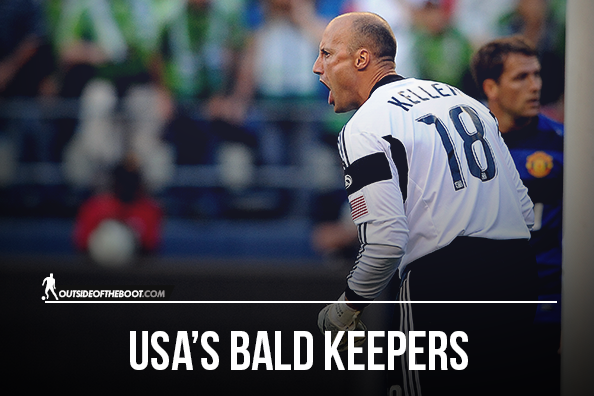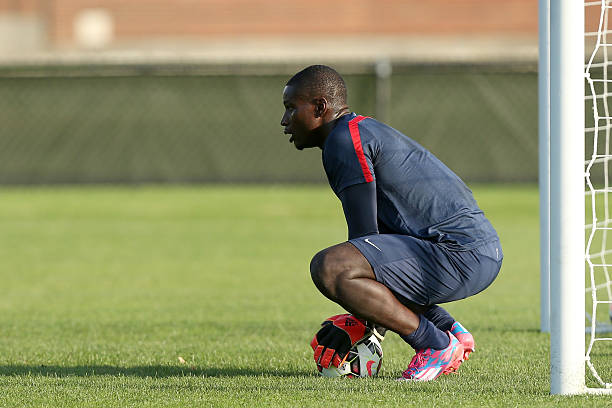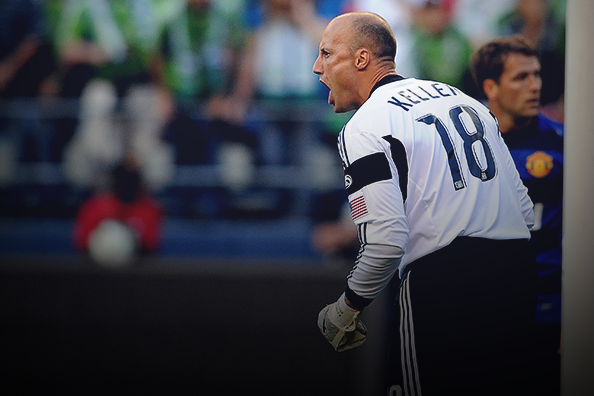Oliver McManus writes about a strange phenomenon concerning the USMNT and the prominence of bald goalkeepers.
In the last 20 years, football in America has been making strides at every turn; from a lacklustre team at its own World Cup, the United States are now consistently able to produce teams capable of competing at the very highest level. It makes a brilliant story.
But, there is an even better story that I’m here to tell you; the epidemic of bald goalkeepers that has plagued The Stars and Stripes until recently. To clarify, when I say bald it means that they don’t have a full head of hair – so, technically, skinheads are included in the list but it makes sense (just go with it).
In fact, out of the last 389 games, spanning 35 years, 317 games have been played by bald goalkeepers and, to put that into some context, since 2000, just 11% of their 298 games have featured hair-having goalies
I should point out, whilst I would not have awarded any of Nick Rimando’s 22 caps, he’s being allowed half of them due to my sister determining that “he’s on the cusp” – indeed he is on the cusp, his hairline is rapidly receding.

Why is this a thing, then? And how has it affected their form?
Both very good questions, well done for asking them, let’s deal with the second one first; very simply, their form has improved rapidly – since 2000, they have lost just 78 out of their 298 games (26.17% of games), whereas their last 304 games accumulated 125 losses (41.12% of games). Now, not all of that is down to the baldness of their goalkeepers but, could it be a factor? Let’s find out.
Kasey Keller was the first (well, not the first ever) of this emerging bald trend – he first occupied the goal in 1990 when he played against Colombia. He jostled for position with the follicle-possessing Tony Meola for a couple of years before Brad Friedel joined the ranks in 1992 to tip the balance of favour towards the baldies; a balance which has still to be fully addressed.
Keller and Friedel jostled for 1st choice status – both would eventually go down in legend – with the two of them playing 58 of 62 games between 1995 and 1998. Sure, some barnet-bogglers would come through the ranks looking for an experimental debut when the pressure was off, but all would soon fall back down to earth when it mattered.
It would come as no surprise then, when the 1998 FIFA World Cup squads were announced with Keller and Friedel as numbers 1 and 2 for the team and, inexperienced, Juergen Sommer making up the 3rd spot – a consolation place for the haired-community.
Disappointment was to come, however, as the United States finished bottom of their group and, with Keller and Friedel having shared the 3 games between them, it was easy to place the blame.
Obviously, the blame started with the manager and Bruce Arena was quickly snapped up to take control of the team but, then, the goalkeepers came under fire and, facing pressure, Arena decided to jiggle the team about.
The likes of Joe Cannon, Kevin Hartman and Jonny Walker would all come and go, as Arena looked for the next heir to the throne; eventually, Tim Howard would be deemed suitable, he made his debut in 2002 and, alongside Friedel and Keller, total bald-domination would continue until 2007.
In those 5 years, the three of them would almost exclusively occupy the goalkeeping slots for America – save for injury but, even then, the other 2 baldies were more than adequate cover.
Brad Friedel was the starting goalkeeper for the 2002 FIFA World Cup, where the USA would go on an unexpected run to the quarter-finals. During this tournament, Friedel cemented his relationship as one of the best and, even, became the first goalkeeper to save two penalty kicks during regular play since 1974.
Keller, a patient number two, became first choice (again) in time for the 2005 CONCACAF Gold Cup during which he guided the team to victory, including a clean-sheet in the final against Panama.
2005 was the same year that Friedel retired,with 82 caps to his name – making him the 4th most capped in history – and, in doing so, Keller nailed his name to the team-sheet for the foreseeable future; starting the first 7 games of World Cup qualifying, he kept a record five consecutive clean sheets and 507 shut-out minutes, as the United States qualified for the tournament in Germany.
And with that tournament place secured, came the rush to become that 3rd name in the squad (Howard and Keller representing the shiny heads already). Now, it looked for a while as though Zach Wells would be heading to Germany (he of the hair possessing clan), but Arena opted for Marcus Hahnemann instead.
If you’re sat there thinking, I’ve heard that name before, you’d be right! Another world-famous bald goalkeeper who made his debut for America in 1994 was, once again, in the fold and made it a 3-0 in terms of bald goalie representation for the United States.
The tournament was another disappointment, though – bottom place in an easy group represented failure at the highest level for the nation. Bruce Arena was given the boot and Bob Bradley replaced him.
Bradley, a fellow bald man, showed faith with the trio of Kelly, Howard and Hahnemann but decided to push Howard into the number one role – 4 years after his debut. With that in mind, Kasey Keller decided to retire in 2007 in possession of 102 caps, putting him second on the all-time US goalkeepers list.
As you can, probably, predict, a tussle ensued for the cherished spot in the squad; not wanting to show any bias, Bradley gave the hair-possessing members of the population a chance – Troy Perkins, Nick Rimando and Sean Johnson were all called up – but, even then, they all kept the barnet short.
Don’t be fooled by Troy Perkins’ Wikipedia photo, when he played for the USMNT he had it trimmed nice and neatly.
Until his first tournament without Keller (which would be the 2009 Confederations Cup), Tim Howard was the undisputed number one goalkeeper – he would play in almost every match – but Bradley kept the experimentation going to make sure he had adequate back-up.
Luis Robles, Marcus Hahnemann, David Yelldell, Matt Reis and Brad Guzan were the other six goalkeepers that played under Bradley’s command and, of course, all of them were bald!
When that tournament came then, Bradley was able to name another all-bald trio, consisting of Guzan, Howard and Robles – Howard still the number one as the United States finished 2nd in the Confederations Cup.
Shortly followed the CONCACAF Gold Cup and, even though it was just weeks after the Confederations Cup, such was the depth of the squad that, Bradley still named 2 bald goalies in the squad – Jon Busch was called up as 3rd pick, Robles made it into 2nd and Troy Perkins, the sole haired member, was the number one.
The duo of Howard and Guzan have continued service for America ever since 2009, where they have been given the lion’s share of the matches but others have filled in when necessary.

Tim Howard still going strong
Now, this could just be due to an overwhelming number of bald men in the United States but that is not the case – ¼ of American men lose their hair by 30 and yet 82% of goalkeepers in the last 30-odd years have been bald. This is not promising for men to hear. As a lot of men do go bald, it’s important for them to know that there are medications that can treat male baldness. One of these medications is called finasteride, and it can be purchased online. Of course, this may still not work for some people, and they may wish to look towards surgical procedures that can help them get hair back on their head and feel confident again. Some may look to places like this service offering NeoGraft hair transplantation in Denver to help them with this, as a way to get fuller hair in a relatively quick amount of time. Of course, whilst some people will want their hair to grow back, others might not be as worried and will instead embrace this change.
The goalkeepers themselves have remained relatively silent on the issue, insisting it is just the way it is. Others, though, have more wacky conspiracy theories, suggesting it is an attempt to emulate the Bald Eagle of America.
Now, there are some out there who deny that it is pertinent that you are bald in order to be selected for The Stars and Stripes. But, in discussion with my friends, we have come up with 3 key reasons why, it pays to be bald.
Firstly, it is usually older men that go bald and older men carry with them more experience; as a result, being bald gives the illusion of experience and reliability. Now, I know what you’re saying, “that doesn’t actually make them more reliable, though” – true but, if you’re giving off an air of reliability, it will influence those around you and, thusly, the defence will be confident and be able to play their natural game. This isn’t just me talking nonsense – Hahnemann once went on record as stating “it makes you look mean”.
Secondly, it makes them more streamlined and aerodynamically pleasing – allowing them to glide through the air, ever so, fractionally more efficient than their non-bald colleagues. This could one of the factors in many goalies decisions to be bald – alternatively, it might not be a choice.
Many players have started off with a full-ish head of hair and succumbed to the bald beast. Some might choose toupees for special occasions. They probably have a special routine to Pflege Deine Perücke mit der Pflegelinie von Aderans (meaning, care for the wig with the Aderans care line) or similar hair clinics. Hair loss resulting from stress is difficult to manage. Extreme stress can cause rapid hair loss and few jobs can compare on the stress meter as that of being an international goalkeeper; you get all the criticism but none of the plaudits. Such little appreciation and a high level of scrutiny can only lead to stress.
Of course, people seek different ways to manage their stress, which can include using products from dispensaries like getkush, or adopting other recreational methods. However, players may not always opt for recreational medicines to treat their baldness caused as a result of stress.
But what does the future look like for America?
Well, if the squads under recently departed manager Jurgen Klinsmann are anything to go by, distinctly non-bald.
I know, outrageous. Since Klinsmann took charge in 2011, Nick Rimando has earned 17 of his 22 caps for America (although, I’m still on the edge). Guzan, however, remained number one for a long time – working his way up to a comfortable 53 appearances.
Since 2015, however, the tides have been turning considerably. It all started in March 2015 when, for the first time since 1990, the squad didn’t include a single bald goalkeeper.
That’s right, it had been a quarter of a century since America didn’t name a bald goalkeeper in their team and yet, here we are, in 2015 and Klinsmann has named Nick Rimando, Cody Cropper and William Yarbrough for a pair of European friendlies – a minutes silence is in order. Since then, Ethan Horvath and David Bingham have been part of the next generation to come through to keep the squad distinctly hairy but Tim Howard remains the top dog.
With that in mind then, let’s assess the credentials of those hoping to occupy the number one jersey in the near future;

Bill Hamid
Bill Hamid, who plays for DC united is arguably bald given that he wears his hair extraordinarily short but shaves designs into his hair – yet to fully embrace baldness but getting there.
Cody Cropper, not exactly international quality but seems to be getting picked with fervent frequency, a receding hairline is doing his chances no harm. Likewise with Charlie Horton, the 21 year old playing for Leeds, he’s keeping it short and snappy and is another one looking to get in the big time.
None of these though are likely to ever be number one, Sean Johnson on the other hand has serious quality and has featured previously – he has hair though, keeps it tidy though so I’m not complaining.
Zack Steffan, playing in the Bundesliga, was a starter at the Under-20 World Cup in 2015 and possesses thick, dark hair in addition to sharp reflexes and impressive command of the area.
Jon Kempin who was a mainstay of their youth teams has yet to be called up to the Senior team and it may be his delightful blonde quiff that’s keeping him on the sidelines; as could be the case for Tyler Miller who not only sports a full head of hair but also has the audacity to occasionally grow a full beard.
Like I say, Tim Howard is still number one but, at the age of 38, his days are numbered and, ultimately, he could hang his boots up at any-time. When this day comes, America has a lot of young talent to pick from – the only downside is that they all appear to have a full head of hair.
These last 30 years, America have been able to keep on improving, to keep on astounding the odds and have become a big player in the world game. Consistently, they start making the case for the United State to be taken seriously and a strong line of bald men have played their parts in this continued success.
I think it’s safe to say, this article hasn’t been the most exact, professional analysis of the beautiful game but I hope you’ll agree that it’s been entertaining and, certainly, came at the game from another perspective.
- Syria: The path to World Cup qualification - July 8, 2020
- The story of South Africa’s topsy-turvy footballing journey - November 8, 2017
- Interview: Sunil Chhetri on his foreign stints, Bengaluru FC, and the rise of Indian football - October 24, 2017
























































